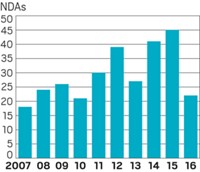Advertisement
Grab your lab coat. Let's get started
Welcome!
Welcome!
Create an account below to get 6 C&EN articles per month, receive newsletters and more - all free.
It seems this is your first time logging in online. Please enter the following information to continue.
As an ACS member you automatically get access to this site. All we need is few more details to create your reading experience.
Not you? Sign in with a different account.
Not you? Sign in with a different account.
ERROR 1
ERROR 1
ERROR 2
ERROR 2
ERROR 2
ERROR 2
ERROR 2
Password and Confirm password must match.
If you have an ACS member number, please enter it here so we can link this account to your membership. (optional)
ERROR 2
ACS values your privacy. By submitting your information, you are gaining access to C&EN and subscribing to our weekly newsletter. We use the information you provide to make your reading experience better, and we will never sell your data to third party members.
Pharmaceuticals
Changing Pharma Paradigms
by Rudy M. Baum
September 26, 2011
| A version of this story appeared in
Volume 89, Issue 39
I recently had the pleasure of moderating a discussion of “New Business Paradigms for Pharmaceutical Companies” between John L. LaMattina and Ronald Breslow at a joint ACS/Société de Chimie Industrielle luncheon in Jersey City, N.J. LaMattina is the former president of Pfizer Global Research & Development, and Breslow is a University Professor at Columbia University and a former president of ACS.
The announcement for the luncheon nicely summed up the situation we face: “Many observers believe the traditional pharmaceutical company model is broken. As patents expire, pharmaceutical companies are having an increasingly difficult time filling their product pipelines with new blockbuster drugs. Firms are responding by cutting back on the number of research programs they pursue and the number of researchers who pursue them. They are trying simpler internal structures and more complex external alliances. Results, however, are slow in coming.”
In my comments, I pointed to an unsolicited e-mail I had received the day before the luncheon from Thomson Reuters Pharma on their Pharma Matters Report. The introduction to the report states: “The ‘2011 Pharmaceutical R&D Factbook’ … paints a gloomy picture of the current health of the pharmaceutical industry: R&D expenditure fell in 2010 to a three-year low of $68 billion, while the number of drugs entering Phase I, II, and III trials fell by 47, 53, and 55 percent, respectively. In addition, only 21 new molecular entities reached the market in 2010, down from 26 in 2009.”
It also states: “This decline in R&D spend is coupled with an increasingly tough regulatory environment, making it more difficult for drugs to progress through pipelines: 55 drugs failed at the Phase III stage during 2008–2010, more than double the number of failures during 2005–2007.”
LaMattina’s comments focused on the negative impact of mergers and acquisitions on pharmaceutical R&D (Nature, DOI: 10.1038/nrd3514), calling them “a major factor in the decline in R&D productivity.” He pointed out that the Pharmaceutical Research & Manufacturers of America had 42 members in 1988, of which only 11 exist today as independent companies. While there are more than 11 current members of PhRMA, “the fact is that, due to industry consolidation as well as some companies dropping their pharmaceutical R&D, there is far less competition in this industry than there was a decade ago.”
Two effects of this trend, he said, are that “multiple entries in a compound class—for example, statins—will be less likely to occur” and “mergers result in the net effect of fewer researchers in big pharma R&D.” Multiple entries in a class are important, he said, because the first drug of a class that reaches the market is rarely the best drug. He also argued that multiple drugs in a class foster price competition. As to the second point—that fewer companies means fewer researchers—LaMattina used Pfizer as an example. In absorbing Warner-Lambert, Pharmacia, and Wyeth, he said, numerous research labs were closed and thousands of researchers let go.
Breslow said that the chemistry enterprise faces a “morale” problem. “We used to tell students that, if you take an advanced degree in chemistry, your career will be secure. That’s not true anymore.” Like LaMattina, Breslow took aim at the consolidation of the pharmaceutical industry. “Mergers may make great financial sense, but they are very destructive,” he said. “And not just to the pharmaceutical industry, but to the chemistry community in general.”
Mergers and acquisitions in the pharmaceutical industry aren’t going away, of course, and LaMattina observed that the biotech industry isn’t immune to the trend. Breslow insisted that the economic strength of the U.S. “is largely based on the strength of our science and technology. Government must continue to recognize that support for science is important.”
Although the discussions and the question-and-answer follow-up were lively and informative, they did not offer much in the way of reassurance for U.S. chemists in the pharmaceutical industry who fear for their futures.
Thanks for reading.





Join the conversation
Contact the reporter
Submit a Letter to the Editor for publication
Engage with us on Twitter